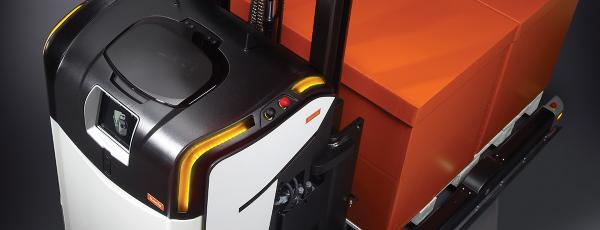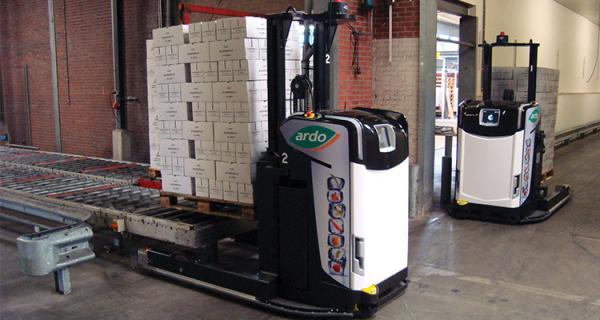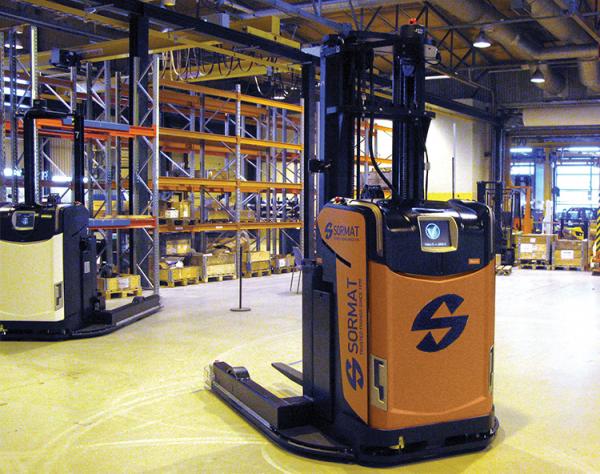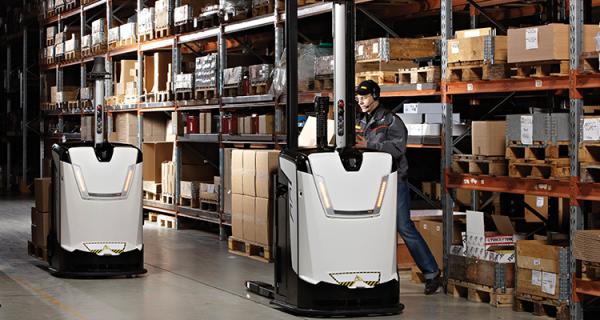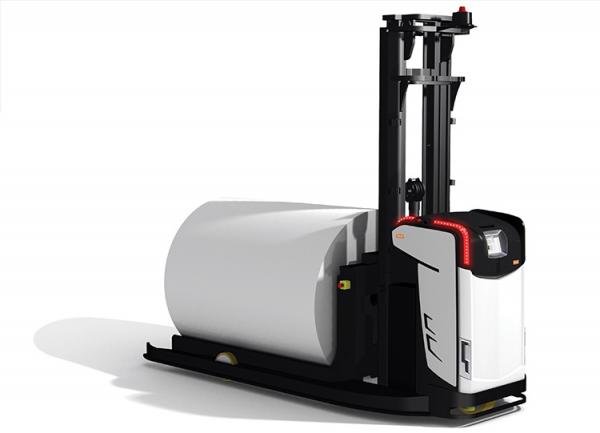By Ruari McCallion
Warehouses see automated guided vehicle (AGV) population explosion
Automation is becoming as familiar in the warehouse as it already is in manufacturing and processing. A growing part of materials handling is going beyond conveyor systems into the territory of automated vehicles. Ruari McCallion looks at developments and speaks to Petri Petäys of Rocla Oy.
As the march of automation continues, it is to be expected that solutions will extend beyond the static, programmed and repetitive robot applications that have become familiar. While conveyor systems have become very sophisticated (just look at airport baggage handling), warehouse management requires automation solutions that are mobile and can be reprogrammed ’on the fly’, as it were; they should be able to undertake a range of tasks at different times without having to stop and pick up new data. Ideally, they should be able to change while on the move. The emergence of unmanned aerial vehicles (UAVs) and driverless cars shows what is possible.
All of this is pretty commonplace for Rocla Oy, whose machinery and equipment undertakes a range of materials handling tasks and has been doing so for a number of years. The Finnish company got into warehouse automation in the 1980s and has been offering AGVs since 1983.
“We talk about ‘automated guided vehicles’,” says Petri Petäys, Sales Director, Rocla Oy, but he stresses that the vehicles are not autonomous – they do not make decisions for themselves. “Most of the AGVs can be guided by laser, wire or measurement of their environment.” Vehicles’ tracks contain certain virtual points along the route, which are comparable to milestones or road signs. When the vehicle arrives at any particular point it asks permission from the supervising system to continue: straight on, turn left, turn right, stop, rotate, and so on. The time may come when warehouse machinery will be able to operate without embedded waypoints, as so-called ‘free AGVs’, but reliable, industrial-scale solutions have yet to be demonstrated. The roles of AGVs today are pretty clear: they carry out tasks that are repetitive, perhaps dangerous, and/or awkward – operating in very narrow aisles and in restricted spaces, for example.
The roles of AGVs today are pretty clear: they carry out tasks that are repetitive, perhaps dangerous, and/or awkward – operating in very narrow aisles and in restricted spaces.
“AGVs are involved in WIP (work in process), in transporting items between manufacturing points; in traditional A to B transport; or in warehouses with various racking systems,” Petäys explains. He is careful to emphasise that AGV systems are typically not ‘standalone’ solutions.
“They are aligned to, and may be fully integrated into, the warehouse management and into the company’s ERP or MRP systems,” he says. It isn’t just about transporting goods: it is about goods and the information related to them. But integration is not all or nothing: a WIP transport system may not require full-scale integration; racking could operate ‘ with an intermediate solution and use automation to achieve higher density in the warehouse. So is it the case that the return on investment (ROI) into an AGV system is better with larger and more complex warehouses or logistics operations?
“Warehouses with 30,000 to 50,000 pallets can benefit from AGVs,” Petäys replies. “The cost implications depend on the tasks to be automated, as well as scale. Two-shift operations will see full ROI in probably 18 to 24 months and three-shift facilities will get ROI in 12 to 18 months.” The actual return in practice will depend heavily on the applications the system is being used for, but there is little doubt that AGVs start off with an advantage.
“The peak capacity of a forklift truck driven by an operator is probably higher but the driver works only six-and-a-half hours out of eight; an AGV will be working eight hours per shift,” he explains. And, like other machines, AGVs do not go on holiday or need time off sick. Also, like other machines, preparation is essential.
“Our main task is to understand customers’ processes,” he continues. “Customers sometimes feel that they are buying a product but they must focus on process.” Rocla Oy starts by looking at the number of transports per hour, the shipping requirements and the working day – 18 hours a day, five days a week, 24/7 or whatever it may be. There will definitely be an interest in the savings that are available, how they will be achieved and the broader human impact.
“There will be savings in labour costs and it is as well to highlight it. And there is the question of safety: AGV equipment is much safer and it is OK to operate it in the same areas as people,” Petäys asserts. “As the equipment and system is integrated into the business’ ERP/MRP solution, traceability of movement of goods is of a very high standard.” AGV equipment is equipped with laser or similar proximity sensors and the machines emit alarms or stop completely, if necessary, which makes them safer in the company of human beings, with their sometimes unpredictable movements and actions, as well as in static landscapes. There are also overload sensors, which cannot be overridden; the machine simply won’t move if it is overloaded.
An AGV will be working eight hours per shift, and like other machines, AGVs do not go on holiday or need time off sick.
“What we often do with a new site is to start with a one-vehicle pilot in a small to medium set of operations,” Petäys says. As each unit is individual, scalability is clearly very flexible; operators can go up singly or by fleets at a time. As has been pointed out, integrating AGVs with the management system is the way to get the best from them so, long-term, freestanding individual units will not deliver the best return.
“At the upper end, AGV systems with several hundred machines can be found in the auto industry, and industries with high-value goods, such as pharma, are investing heavily as well,” he says. “In the end, there is no real upper limit.” As emerging markets – and China especially – are taking an increasing interest, it seems that the reliance on low wages is declining. This is good news for the more expensive labour markets of the West – but also indicates that businesses in advanced economies should be paying attention as well.
Petäys concludes: “It isn’t just about labour costs, however. You can control WIP very tightly, get better feedback and achieve a more effective use of the whole plant with AGVs. The key is to have goods ready, when they are needed and where they are required, and the AGV will deliver in precise accordance with the order.”
